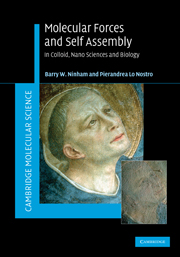Book contents
- Frontmatter
- Contents
- Preface
- Part I Molecular forces
- 1 Reasons for the enquiry
- 2 Different approaches to, and different kinds of, molecular forces
- 3 Electrostatic forces in electrolytes in outline
- 4 The balance of forces
- 5 Quantum mechanical forces in condensed media
- 6 The extension of the Lifshitz theory to include electrolytes and Hofmeister effects
- 7 Specific ion effects
- 8 Effects of dissolved gas and other solutes on hydrophobic interactions
- Part II Self assembly
- Index
- References
5 - Quantum mechanical forces in condensed media
from Part I - Molecular forces
Published online by Cambridge University Press: 06 January 2011
- Frontmatter
- Contents
- Preface
- Part I Molecular forces
- 1 Reasons for the enquiry
- 2 Different approaches to, and different kinds of, molecular forces
- 3 Electrostatic forces in electrolytes in outline
- 4 The balance of forces
- 5 Quantum mechanical forces in condensed media
- 6 The extension of the Lifshitz theory to include electrolytes and Hofmeister effects
- 7 Specific ion effects
- 8 Effects of dissolved gas and other solutes on hydrophobic interactions
- Part II Self assembly
- Index
- References
Summary
Lifshitz theory and its extensions: an overview
Molecular recognition
The ideas behind the DLVO theory of long-range forces in colloidal particle interactions and of the electrical double layer that we have just outlined held centre stage in colloid science for at least 70 years. Quantitatively, as already remarked, agreement between experiment and theory was illusory, except at salt concentrations less than 10−2 M, or at most 10−1 M. It was illusory in the sense that while classical theory captured some essentials of the forces between ions and macromolecules, ion specificity was still missing. While the electrical double-layer forces decayed exponentially as predicted, the magnitude of the forces changed with a change in counterion or co-ion. Recall our typical examples. A change in counterion in a background electrolyte from Br− to OAc− could produce an increase in magnitude of the forces by a factor of 50 to 100! The same will be seen to occur with different surfaces with a change from Na+ to Li+. We will see much more of this specificity later. These differences depended on the nature of the charged interacting surfaces and, at the same electrolyte concentration, on the counterion. They occur even with a change in an apparently indifferent co-ion in an intervening electrolyte. The accommodation of such results could only be achieved by calling in more unquantified fitting parameters. This is unsatisfactory as predictability is lost. The attractive van der Waals forces were obscured by short-range effects due to solvent structure.
- Type
- Chapter
- Information
- Molecular Forces and Self AssemblyIn Colloid, Nano Sciences and Biology, pp. 84 - 111Publisher: Cambridge University PressPrint publication year: 2010



